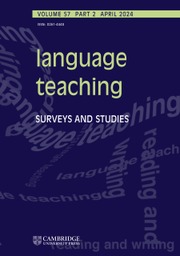Crossref Citations
This article has been cited by the following publications. This list is generated based on data provided by
Crossref.
Soulé, María Victoria
and
Pérez-Vidal, Carmen
2021.
Advanced learners of Spanish abroad.
Study Abroad Research in Second Language Acquisition and International Education,
Vol. 6,
Issue. 2,
p.
244.
Woo, Jin Ha
and
Choi, Heeyoul
2021.
Systematic Review for AI-based Language Learning Tools.
Journal of Digital Contents Society,
Vol. 22,
Issue. 11,
p.
1783.
Sadeghi, Karim
2022.
Talking About Second Language Acquisition.
p.
141.
Guedes Seccato, Mariana
Reichert Assunção Tonelli, Juliana
and
Vitalina Selbach, Helena
2022.
A panorama of the teaching of additional languages to children in Brazil.
Revista Letra Magna,
Vol. 18,
Issue. 29,
p.
34.
Sadeghi, Karim
2022.
Talking About Second Language Acquisition.
p.
1.
Fogal, Gary G.
and
Koyama, Dennis
2022.
A study of co-adaptation through journaling.
Journal of Second Language Writing,
Vol. 55,
Issue. ,
p.
100873.
Atkinson, Dwight
Burhan-Horasanlı, Elif
Sagre Barboza, Anamaría
Mejía-Laguna, Jorge Andres
Oguilve, Verónica
and
Ribeiro, Amable Daiane Custodio
2023.
Beyond learning opportunities: focused encounters in a sociocognitive approach to second language acquisition and teaching.
International Review of Applied Linguistics in Language Teaching,
Haroon, Sidra
Aslam, Muhammad
and
Saleem, Tahir
2023.
Exploring the cross-linguistic functioning of the Principles of WH-Movements: The case of Pakistani ESL learners.
Cogent Arts & Humanities,
Vol. 10,
Issue. 1,
Tragant, Elsa
and
Muñoz, Carmen
2023.
Ten Years of English Learning at School.
p.
1.
Li, Chili
Liu, Bingjie
and
Wang, Xiaoxue
2023.
A scoping review of research on languaging in second language education.
Heliyon,
Vol. 9,
Issue. 5,
p.
e16300.
Lopriore, Lucilla
2023.
Handbook of CLIL in Pre-primary Education.
p.
17.
Crosthwaite, Peter
Ningrum, Sulistya
and
Schweinberger, Martin
2023.
Research trends in corpus linguistics.
International Journal of Corpus Linguistics,
Vol. 28,
Issue. 3,
p.
344.
Liu, Wei
2023.
The theory of second language development for international students.
Journal for Multicultural Education,
Vol. 17,
Issue. 3,
p.
367.
Kjelaas, Irmelin
2024.
Linearity, delay, and lost language learning opportunities. Newly arrived adolescent students’ experiences with school segregation in Norway.
Scandinavian Journal of Educational Research,
Vol. 68,
Issue. 5,
p.
969.
Plonsky, Luke
2024.
Study quality as an intellectual and ethical imperative: A proposed framework.
Annual Review of Applied Linguistics,
p.
1.
2024.
A Practical Guide to Second Language Teaching and Learning.
p.
22.
Tai, Tzu-Yu
and
Chen, Howard Hao-Jan
2024.
The impact of intelligent personal assistants on adolescent EFL learners’ listening comprehension.
Computer Assisted Language Learning,
Vol. 37,
Issue. 3,
p.
433.
Walter, Daniel R.
Fischer, Galya
Cai, Janelle
and
Fernandes, Thiago P.
2024.
The effect of cue length and position on noticing and learning of determiner agreement pairings: Evidence from a cue-balanced artificial vocabulary learning task.
PLOS ONE,
Vol. 19,
Issue. 7,
p.
e0302355.
Liu, Ziman
Chen, Shifa
and
Wang, Shaoxin
2024.
The role of psycholinguistics in instructed second language acquisition
Psycholinguistic approaches to instructed second language acquisition: linking theory, findings and practice
, by Daniel R. Walter, Bristol, Multilingual Matters, 2023, v+224 pp., USD 40.00 (paperback), ISBN 9781788928748
.
Philosophical Psychology,
p.
1.
Al-Hoorie, Ali H.
Hiver, Phil
and
In’nami, Yo
2024.
The validation crisis in the L2 motivational self system tradition.
Studies in Second Language Acquisition,
Vol. 46,
Issue. 2,
p.
307.



